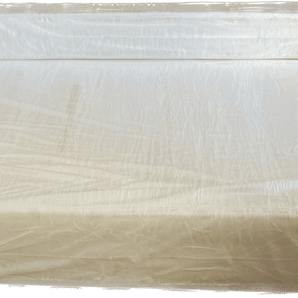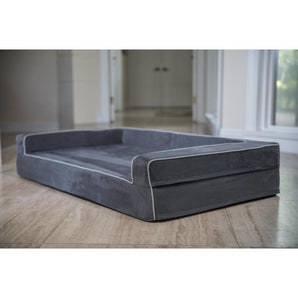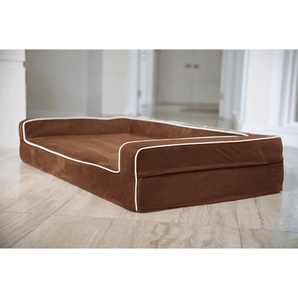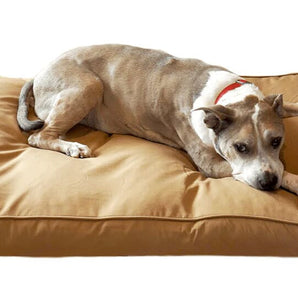
Owning a dog and keeping them out of mischief can be hard work. Whether that’s training them to use a puppy pad, to stay out of the kitchen, or stay away from harmful cleaning supplies; keeping them safe and protected can be a difficult task. That’s why I’ve created this list of ways to dog proof each area of your home and keep your dog safe.
How to Dog-Proof Your Kitchen
There are multiple ways for your pup to get hurt in the kitchen. Some owners avoid having their dogs in the kitchen altogether to avoid mishaps -- whether that’s training them to only stand in the doorway or putting up a gate to prevent them from entering.
If you’re okay with your dog entering the kitchen, one way you can dog-proof your kitchen is by keeping your trash away and contained. Dogs are known to tamper with the trash and if there are things like gum, coffee pods, cleaning soaps, or alcohol, they could be seriously injured if they ingest these items.
Another way to dog proof your kitchen is by placing cleaning supplies, medications, and foods that would be harmful to your pup on high shelves or behind closed or locked doors. This prevents them from getting into them and ingesting something harmful that could permanently harm your dog. Child proof cabinets or outlet covers aren’t necessary unless you have a pup that is particularly mischievous and knows how to get into those things.
How to Dog-Proof Your Bathroom
It’s best to keep your dog out of the bathroom, but if they insist on being in there with you, dog proofing the bathroom is very similar to dog proofing the kitchen. First, ensure that the trash is covered or out of sight. Next, make sure that the cleaning supplies, soaps, and hair gel is out of reach.
Then I’d advise you to keep the toilet seat down and the toilet tissue on a roll that your pup won’t be able to get to. You don’t want them to get sick from ingesting tissue or drinking water or harmful chemicals from the toilet bowl.
For dogs, human medications are a common source of poisoning, so it’s important to lock your cabinets with your medications and supplements that might be lying around your bathroom so your dog doesn’t get to them.
How to Dog-Proof Your Living Room
I know the living room is where you and your dog may spend the most time together, so it’s very important that you dog proof this area by covering and containing cords. If your dog gnaws on cords, they could potentially get shocked, burned in the mouth, or face much worse consequences. So it’s super important that you’re covering and protecting your pup from this potential issue.
Another viable option is to use deterrent sprays on the areas in the living room that you want your dog to steer clear from. It’s a smart idea to additionally make sure any houseplants you have are out of the way -- especially if you have some that are poisonous or harmful to your dog. I also recommend keeping breakable items out of reach from your pet. Whether it’s a fancy vase or an expensive kids toy, put them out of the way so your dog doesn’t knock them over and harm themselves.
While you want to ensure that your dog doesn’t get into something he shouldn’t, you also want to provide your dog with his own designated space in the living room. This can be a crate or a dog bed, but either way you should aim to create an area for them that they can retreat to and be comfortable in.
How to Dog-Proof Your Bedroom
For many of us, the bedroom is a place for relaxation. And if you’re like me, that often includes your dog laying in bed with you. While we like to have our furry companion with us, it’s just as important that we take the proper precautions to dog proof our bedrooms as well.
First, make sure that your lotions, creams, perfumes, or oils are not within reach to prevent poisoning or causing harm to your dog. You should also keep your chewable or valuable belongings like a pair of new shoes out of sight and put away. Shoes, strings, and buttons could potentially cause a choking hazard with your pup if they ingest them.
Another thing in the bedroom that can be extremely dangerous for dogs is batteries housed inside of remotes, toys, keys, etc. The batteries inside these items can be chewed on and swallowed and if ingested, could potentially burn the soft tissue in your pup’s stomach.
If you’re into creating crafts in your bedroom or if you have a craft room, be sure that sharp objects like needles and scissors are out of reach. You don’t want your dog to get cut or seriously injured by those things.
Also, be wary of open doors and windows, while they can provide fresh air, they also can serve as a way for your dog to easily escape. Be sure to add screens to help keep your pup from jumping out of your windows and possibly running out into the street.
How to Dog-Proof Your Backyard
If you have a fenced backyard, you may be under the impression that your backyard is already dog-proofed. While it is to a certain extent, there are still additional ways to keep your dog safe in that open space. Make sure to check the fence for any holes or spaces that your dog could pass through or any low hanging fences that your dog could jump over. You might want to consider patching those areas up.
Also analyze what lawn chemicals, mulch, fertilizer, compost piles, and poisonous plants you may have in your yard. It’s important to ensure that whatever chemicals you are using, are pet safe in case your dog ingests them while they are out playing in the yard.
If you have a pool or a pond, make sure that they are properly fenced and maintained so you can keep your pup safe while they play. We know that naturally your dog may be very curious and rightfully so! But it’s important to provide a safe environment for your dog to roam. Hopefully these tips will help keep your dog safe and your home protected.




